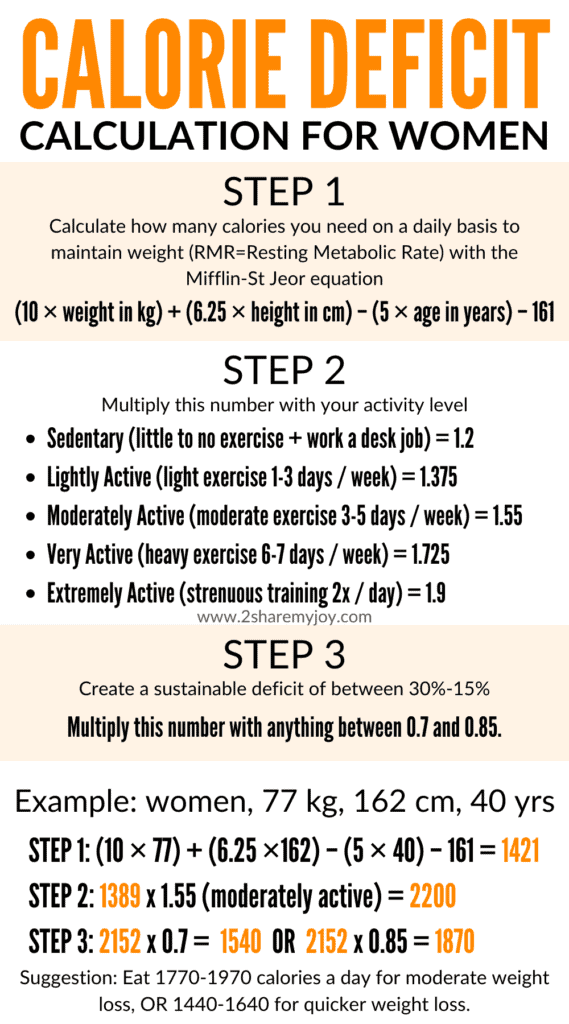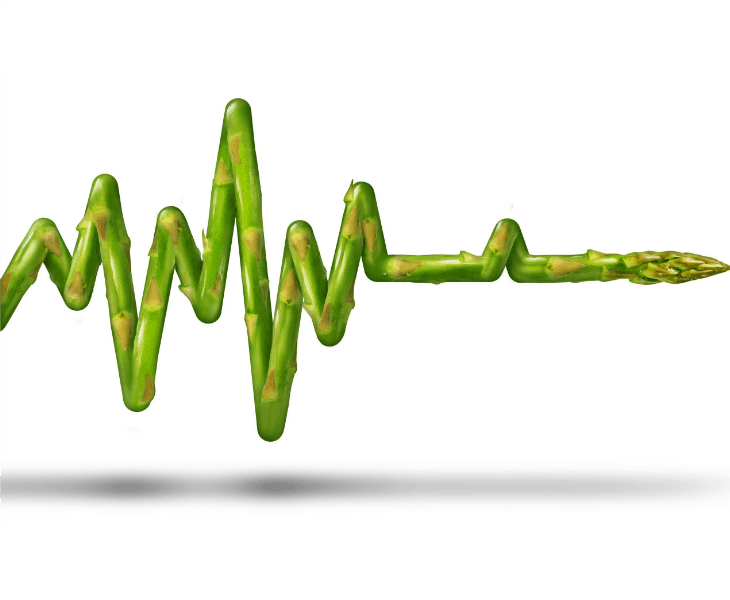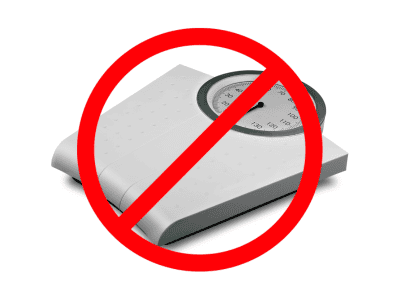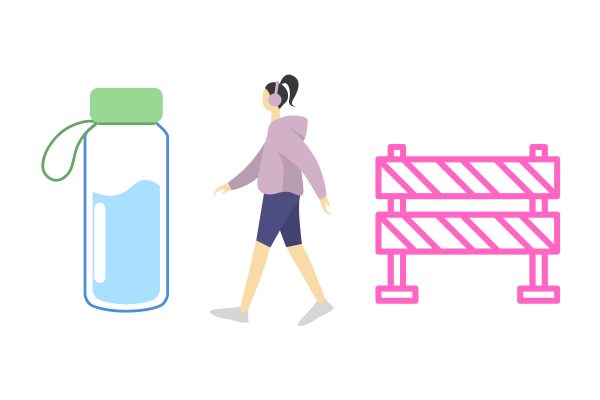How Many Calories Should I Eat To Lose Weight
Embarking on your weight loss journey requires an understanding of a vital concept: calorie balance.
You may have heard to reduce calories to lose weight. However, there are many ways to do so and some problems that may arise.
Finding out how many calories you should eat to lose weight can be a bit tricky. Here are the key takeaways:
- Calorie balance is key to weight loss: Understanding the calorie intake versus calorie expenditure equation is crucial.
- Achieving a sustainable caloric deficit: It’s not merely about eating less but finding a healthy balance that supports long-term weight management.
- Avoid drastic reductions: Calorie intake should not be severely restricted to prevent nutrient deficiencies and metabolic shifts.
Step 1: Determining Your Calorie Needs
First, let’s look at how many calories you need on a daily basis to maintain weight (RMR=Resting Metabolic Rate).
The Mifflin-St Jeor equation has emerged as a cornerstone for accurately gauging your RMR. The resting metabolic rate number is the calories you need at rest but accounts for low-energy tasks like eating and walking around a bit.
Embracing this equation means embracing a science-backed pathway towards understanding what your body truly demands for optimal functioning, especially when weight loss is the goal.
It intricately factors in age, size, sex, and activity level, ensuring a personalized touch to the numerical figure you receive. Age, often overlooked, affects metabolism.
Size, whether in terms of muscle mass or overall body constitution, influences how many calories you burn at rest. Sex plays a crucial role, with metabolic distinctions between males and females.
Here is the equation:
- Men: (10 × weight in kg) + (6.25 × height in cm) – (5 × age in years) + 5
- Women: (10 × weight in kg) + (6.25 × height in cm) – (5 × age in years) – 161
For me, this would look like this:
(10 x 64.4) + (6.25 x 172) – (5 x 35) – 161 = 1389
Lastly, your activity level shifts your calorie needs dramatically. Now you multiply this number with the activity level:
- Sedentary (little to no exercise + work a desk job) = 1.2
- Lightly Active (light exercise 1-3 days / week) = 1.375
- Moderately Active (moderate exercise 3-5 days / week) = 1.55
- Very Active (heavy exercise 6-7 days / week) = 1.725
- Extremely Active (strenuous training 2x / day) = 1.9
For me this would look like: 1389 x 1.55 = 2152
As with any calculation, the number could be off by 50-100 calories a day.
However, it is a good starting point, and a weight loss strategy needs regular adjustments either way.
Step 2: Creating a Sustainable Calorie Deficit
Now, we are looking at how many calories you should eat less to lose weight. I know there is this rule around the internet that eating 500 calories less will help you lose 1 pound per week.
While this can be true for some, there is a more accurate way to calculate this. Calorie reduction depends on your current caloric needs for your individual body composition and activity levels.
Therefore, I like to suggest a percentage of 15-30% caloric deficit. If you want to slowly lose weight, go with 15%; if you want to speed things up, go with 30%.
Using my example, I prefer to go slow:
2152 x 0.85 (eating 85% of my total calories burned a day, so 15% less) = 1829 calories a day.
I like to give my clients a range of +/- 100 calories to this number. This just helps to be more flexible and not too stressed trying to reach your caloric goal. So, I would eat between 1750 and 1950 calories a day.

Step 2.2: Body composition consideration
There is another consideration for choosing the right caloric deficit for you. If you currently have a lot of fat you want to lose, you can start with a 30% caloric reduction.
To lose only a bit of fat, aim for 20%. If you already have a lot of muscle and want them to look more lean (just lose a bit of fat), then go with a 10-15% caloric reduction.
Step 3: Adjusting caloric intake after 3 weeks
Don’t be alarmed if your scale jumps up a few pounds on some days. This is not necessarily a sign that your calorie strategy isn’t working. Scale weight can fluctuate depending on water retention and other factors.
Here is the best way to check your weight loss progress:
- Weigh yourself every day at the same time, under the same conditions. For example, right after waking up and using the bathroom, with pajamas on.
- Write down your weight for 3 weeks. At the end of each week, calculate your average weight for that week.
- Compare the average weight of week 3 with week 1.
- You are making great progress if you have lost more than 0.5% of your body weight, and you can keep going.
In my example, I would compare my weight at the end of week 3 with my weight at the end of week 1 (2 consecutive weeks of weight loss). If my weight at the end of week 1 was 142 lbs., then a 0.5% weight loss would be (142 x 0.005 = 0.71 lbs.) 141.3 lbs.
What If I have a Fitness Tracker?
If you have a fitness tracker, skip step 1. Instead, go into your app and check how many calories you burn each day.
It’s best to look at an average, so take the average for the past three weeks. Make sure you have worn your tracker consistently during that time.
Now that you know how many calories you burn on average, you can proceed with step 2 and calculate your deficit. This is a good starting point but may need adjustment over time.
What If I still don’t lose weight (troubleshooting)
There are a few reasons why you still aren’t losing weight.
When calculating your activity level, make sure to keep the same level each week. If you end up working out less, you need to include this change in your calculation.
When we reduce calories too much, our bodies automatically try to save energy. You may unconsciously rest more between workouts, which reduces the calories you burn in a day. My advice is to add a quick 10-minute walk even on the days you work out.
If you work out in the evening, add a quick walk during lunch. This will help keep your metabolism active.
Journaling food intake can also be tracked inaccurately and can lead to unsuccessful weight loss. A food scale that weighs your food can help. Also, prepped meals can help in hitting caloric goals.
Make sure to account for drinks and condiments when tracking food as well. They are often forgotten and can add up quickly.
If troubleshooting exercise and food intake does not help, you can reduce food intake by another 10%. This can be as simple as ditching one daily snack or swapping one soda with diet soda.
If your weight loss strategy has worked for a while but then stopped working, this is actually quite normal. Some call it the weight loss plateau.
When you lose weight, your energy needs change as well. If you have this problem, go ahead and redo the calorie calculation above with your new weight. This will give you a new caloric intake range for weight loss correlating with your new weight.
Importance of Nutritional Quality
Focusing exclusively on caloric intake overlooks a crucial aspect of weight loss: the significance of nutritional quality. Consuming nutrient-rich foods is key to averting nutrient deficiencies and metabolic changes.
Eating enough protein and fiber will also curb cravings, making it much easier to stick to your healthy diet.
If you find yourself hungry often, even if you haven’t significantly reduced your caloric intake, it could be helpful to consider your food quality.
A couple of recommendations I like to give are to consume between 20g and 40g of protein with every meal and to add fruits or vegetables to every meal. This approach is easy to follow and can help increase fiber, protein, vitamins, and minerals.
More resources:






